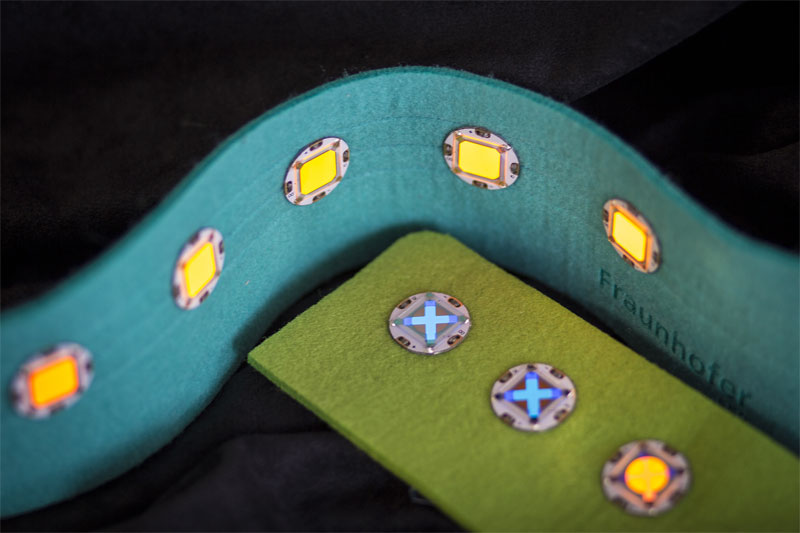
Flexible OLEDs to Provide Customizable Lighting Functionality in Textiles
DRESDEN, Germany, Sept. 7, 2018 — Scientists at the Fraunhofer Institute for Organic Electronics, Electron Beam and Plasma Technology (Fraunhofer FEP) have made advances in OLED elements for integrating into textiles. The OLEDs can not only light up in color, but can also be designed in any shape and can be made transparent or dimmable.
To simplify the integration of OLED elements in clothing and give designers more options for their use, the researchers developed a functional button, called ‘O-BUTTON,’ that combines a wafer-thin foil-based OLED with a microcontroller on a conventional circuit board. The circuit board, which is in the shape of a button, is attached to the textile with conductive yarn. The O-BUTTON is supplied, and controlled, with electrical power. The OLED itself is continuously dimmable.

The O-BUTTON will enable customer-specific OLED elements for textile integration. Courtesy of Fraunhofer FEP/ Jan Hesse.
The O-BUTTON is an output device and can emit light as a standalone device or as a matrix via Inter-Integrated Circuit (I2C)-driving. The researchers said that the emission area can be patterned to any design, making it possible to create OLEDs of various sizes and designs. Two-color-variable variants of the O-BUTTON are also possible. The O-BUTTON can be combined with a touch sensor, integrated on an energy-harvesting module, or equipped with an organic solar cell instead of an OLED.
The researchers believe that the range of applications for their customizable OLEDs is diverse and not limited to fashion trends or brand design elements. Since OLEDs can be adapted to specific wavelength ranges, applications in medicine are conceivable. For example, shirts with integrated flat IR lights could be developed for use in light therapy. The OLEDs could also be incorporated into workwear for night-time workers.
Researcher Jan Hesse said, “The integration of luminous elements in clothing not only freshens up fashion designs, it can also create very concrete benefits: Luminous logos or applications are more easily noticed and considerably increase the visibility and thus the safety of the wearer, e.g. in road traffic.”
According to the team, there are almost no limits to the structuring of their OLED technology, and textiles finished using this technology could inspire innovative designs and open up further areas of application. The researchers estimate that the first OLED fashions will be on display in stores in about three years.
The team will present on OLED elements that can be integrated into textiles at the Electronics System Integration Technology Conference 2018, Sept. 18-21 in Dresden, Germany.
Published: September 2018